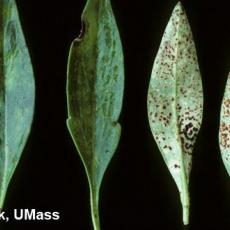Rust diseases are a common fungal infection that affect a wide range of floricultural crops, including Aster, Carnation, Fuchsia, Florist'sgeranium ( Pelargonium X hortorum ) Gladiolus, Lilium, Marigold,Poinsettia, Snapdragons, Statice and Viola (including pansy). Rusts have the potential to negatively impact floriculture production because these pathogens often cannot be detected on infected, but symptomless propagation material entering the United States or moving state-to-state. Rust fungi are obligate parasites, dependent upon a live host for growth and development,and seldom kill plants. However, rust infection reduces plant health and vigor,flower production, and aesthetic value. Each type of Rust has its own distinctive symptoms and its own specific plant hosts.
The disease often first appears as chlorosis on the upper surfaces of leaves. All rust fungi produce powdery masses of spores in pustules, typically on leaf undersides that are yellow, orange, purple, black or brown. Some Rust fungi produce pustules on upper leaf surfaces as well. Spores are easily spread on air or with splashing water. Lesions may coalesce resulting in large areas of necrosis; leaf distortion and defoliation often follow.
- Purchase only disease free plants or cuttings. Carefully inspect all incoming plant shipments for rust symptoms.Keep new plants isolated from established plants for up to three weeks to allow rust diseases to develop, if present.
- Scout regularly for rust diseases. Frequently remove all Rust-infected leaves and badly infected plants and destroy by burning, rapid composting, or burying. At the end of the growing season, carefully clean up and destroy all crop debris.
- Sterilize benches and propagation rooms with an appropriate greenhouse disinfectant.
- Keep the humidity within the greenhouse at less than 80%. Increasing air movement by adding fans which will prevent moisture from condensing on the foliage. Practice only surface watering and avoid splashing water onto foliage. If overhead irrigation is necessary, water in the early morning when plants will dry quickly.
- Space plants far enough apart to allow for good air circulation. In the case of outside varieties, such as rose or Violas, in the fall, carefully clean-up and all leaf litter and destroy. Severely infected roses can be dramatically pruned.
- A combination of cultural and chemical control is often required to control rust diseases. There are many effective rust products and these should be applied on a protective basis according to label instructions. Be sure to rotate applications between chemical classes to prevent fungicide resistance from developing.

